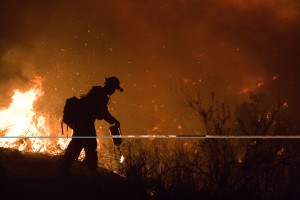As wildfires burn homes and thousands of square miles across the West, fire experts say simple actions like clearing brush around a home or removing pine needles from decks could make the difference in whether a house survives or burns to the ground.
Fire science research over the last decade has produced strategies that can help reduce a home’s chances of igniting, and fire officials are trying to spread the word in fire-prone areas that these little things are hugely important.
“It hard to provide 100 percent guarantee on anything, but there are a number of things homeowners can do – and a lot of them are small but also important,” said Steve Quarles, a senior scientist with the nonprofit Florida-based Insurance Institute for Business & Home Safety.
 Whether a home makes it through a fire often depends on what is or is not in the zone surrounding it, known as defensible space, as well as the design and materials used in home construction, Quarles said.
Whether a home makes it through a fire often depends on what is or is not in the zone surrounding it, known as defensible space, as well as the design and materials used in home construction, Quarles said.
Property owners can reduce their risk of wildfire damage by choosing metal roofs over wood shake roofs, for example, keeping flammable materials such as firewood piles away from the home, spacing trees farther apart and by clearing brush from nearby roads.
Increasingly, homeowners and communities are seeing the benefits of such strategies, and they’re joining voluntary programs such as the National Fire Protection Association’s Firewise Communities.
“Interest is growing as people understand that they actually have a role to play,” said Lucian Deaton, senior program manager for Firewise, which is partly paid for by the U.S. Forest Service.
More than 1,000 communities in 41 states are recognized as “firewise” because they’re taking steps to prepare their homes from wildfire risks.
Still, that represents a small fraction of the estimated 72,000 communities located in wildfire-prone areas.
Experts say that’s because some people don’t fully understand wildfire risks, or they don’t think it will happen to them. Others only live part-time in second homes in fire country, while some are independent and don’t want more regulations or intrusion.
Some governments, however, are incorporating wildfire-prevention strategies into building codes, including the state of California, Washoe County, Nevada, Flagstaff, Arizona, and Yakima County, Washington. But such regulations can be controversial, so voluntary measures are often seen as more effective in getting people involved in preparing for potential wildfires.
In Washington, wildfires so far have destroyed more than 300 homes, scorched nearly 600 square miles and cost more than $160 million in firefighting costs.
The cost of fighting just one fire – the largest burning in north-central Washington – has already surpassed the state’s $19 million annual budget for fire suppression, said Mary Verner, deputy supervisor for resource protection and administration with the Department of Natural Resources. Fire suppression for that fire is estimated at $87 million, which will be split by local, state and federal agencies.
In July, as that wildfire raged near their forested home south of Okanogan, Peggy and Noble Kelly fled and hoped for the best.
Returning to assess the damage two days later, the couple was relieved but not surprised to find that their home and outbuildings had been spared. Flames burned within 50 feet of their home.
The couple credited firefighters, luck and proactive steps they had taken to reduce wildfire risk: clearing brush, thinning trees, keeping their grass low, constructing a metal roof and choosing a rock garden rather than other vegetation near their deck.
The fire was so intense that some homes probably wouldn’t have been spared, Peggy Kelly said, but being proactive helped “save our home. The work we had done allowed firefighters to defend our place from the fire.
“If I protect my place, my neighbors’ place is also protected,” said Kelly, whose Chiliwist Valley community joined the Firewise program last year. “And if he protects his, eventually the whole community may be protected.”
That doesn’t necessarily mean a wildfire won’t hit, but it does help, she and others said.
Kirsten Cook, who has been helping homeowners evaluate wildfire risks, said there’s a sense of urgency after this year’s devastating fires. More than 50 people showed up at a workshop in Mazama on Saturday, and nearly two dozen households signed up for evaluation.
“It’s about resilience because we live in a wildfire landscape,” said Cook, education and outreach coordinator with the Okanogan Conservation District. “It’s going to happen. It’s not a matter of if, it’s when.”
Was this article valuable?
Here are more articles you may enjoy.

 Atmospheric River to Flood Pacific Northwest Through Week
Atmospheric River to Flood Pacific Northwest Through Week  NYT, Chicago Tribune Sue Perplexity AI as Copyright War Rages On
NYT, Chicago Tribune Sue Perplexity AI as Copyright War Rages On  Losses Top $20 Billion in Asia Floods as Climate Risks Grow
Losses Top $20 Billion in Asia Floods as Climate Risks Grow 